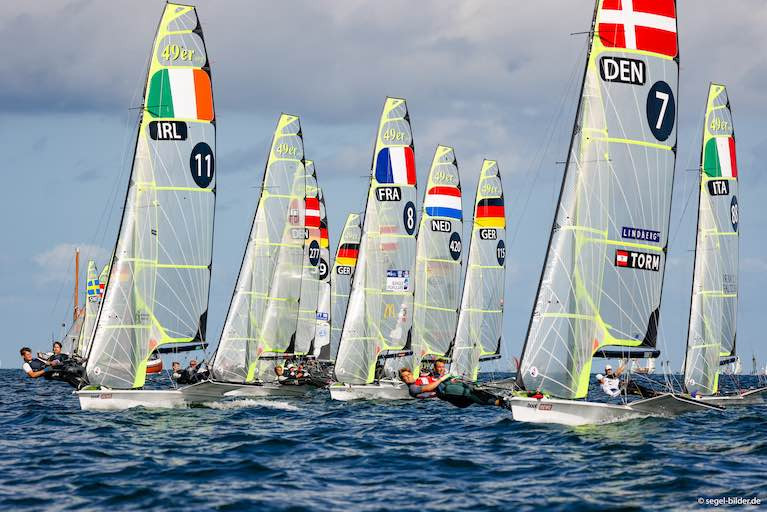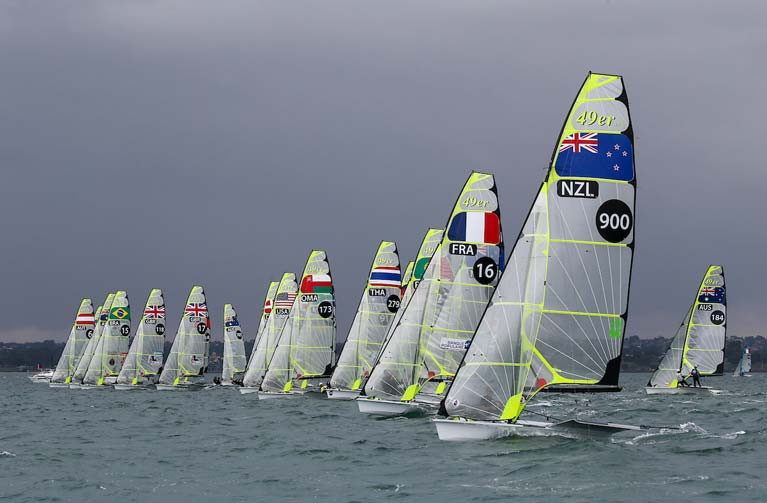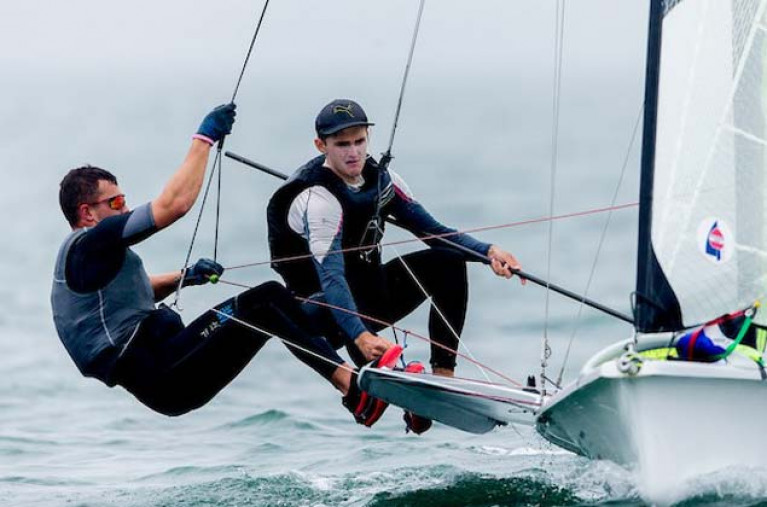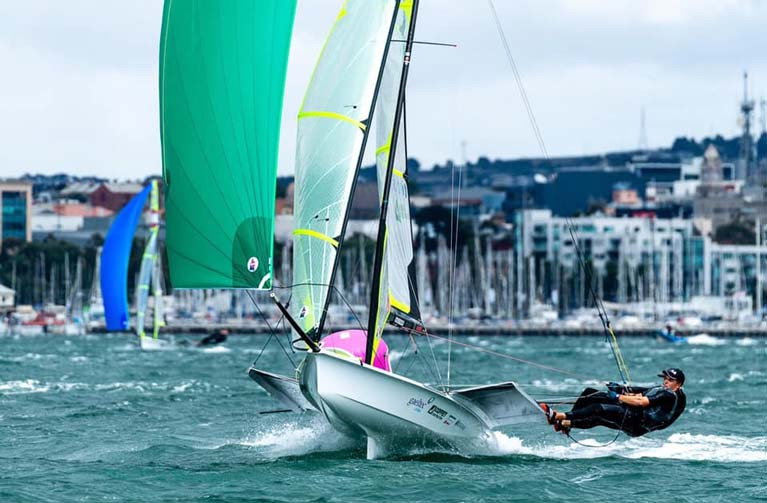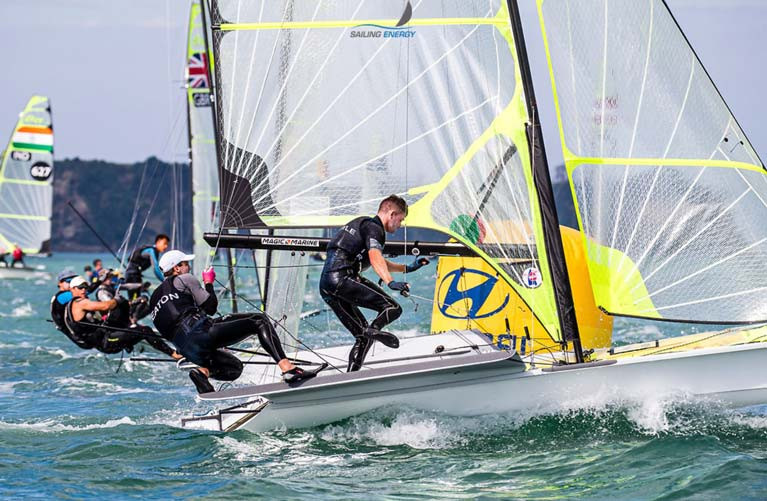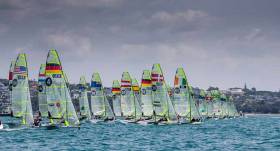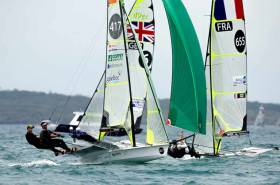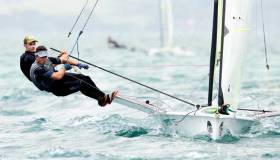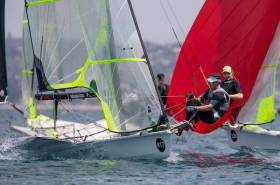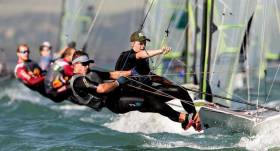Displaying items by tag: 49er
Howth Yacht Club's Dickson & Waddilove Lead Irish 49er Hopes at Kiel Week in Germany
Two Irish Tokyo rivals both now in the hunt for one of the final European Olympic berths have resumed their battle after COVID at a scaled-down Kiel Week Regatta 2020, in northern Germany this week.
With two races left to sail its Howth and Skerries duo Robert Dickson and Sean Waddilove that lead Irish hopes in 15th in the 52-boat fleet with two final races left to sail today. The pair, who also recorded the top Irish result at the 2020 World Championships in Australia in February, are in the top 30% of the fleet and as such it makes a welcome return to the race track, except for a UFD penalty in yesterday's final race of the day.
The Belfast and Cork combination of double Olympian Ryan Seaton and Seafra Guilfoyle will have probably been looking for more out of the week on the Baltic than their current 32nd position in the international fleet.
Both the 49er teams will head to Austria for the 49er European Championships, from 28 Sept – 4 October on Lake Attersee, a notoriously tricky venue.
As Afloat reported previously Irish campaigns chasing last places in the 49er, Laser and Finn classes were in turmoil in Spring when COVID-19 hit key final European qualifications in Italy and Spain, ultimately postponing the Games itself.
Ireland is competing with Belgium, Sweden and Italy for the one remaining European place. Form at the 2020 Worlds suggests that Irish sailors would be favourites for the place having finished ahead of the other three candidates but the final selection system has yet to be confirmed.
Irish 49ers Miss Gold Fleet Cut at 49er Worlds
Leading Irish 49er duo Robert Dickson and Sean Waddilove of Howth Yacht Club dropped ten places in the overall standings to be just a single place outside the all-important gold fleet cut-off at the 2020 49er World Championship in Geelong, Australia.
The qualification series was reduced after the first day of racing was lost to weather. Racing continues until Saturday in gold and silver fleet splits.
Irish rivals for Tokyo 2020, Ryan Seaton and Seafra Guilfoyle improved overall jumping from 49th to 34th in the 78-boat fleet and their scoresheet includes a second place in race five, an individual score to compare to the race win of Dickson and Waddilove in the opening race of the championships.
Reigning 49er world champions and Rio 2016 Gold medallists, Peter Burling and Blair Tuke (NZL), bagged enough low scores in the qualification round to lead at the midway point of the qualification round
The top 25 49er teams go through to gold fleet to fight in the coming three days for the world title, and Burling/Tuke are primed to defend their crown, which would make it six for the canny Kiwis.
“It’s good to get through the qualifying series with some low scores, we didn’t sail our best at times, but we had some pretty good comebacks to make up for it. It was pretty tricky out there, plenty of shifts,” Burling said during the derig. “Tomorrow looks pretty similar in terms of the forecast - it should be nice. All the good guys are still here and pushing hard.”
Chasing they are, as the top six teams through qualifying were all in the top eight at the 2019 Worlds. With so many highly-ranked teams close on points, the gold fleet racing will be dramatic. Join us from 1100hrs (AEDT) to watch all the action.
The city of Geelong in the southern state of Victoria awoke to steady rain, grey skies and mist which affected visibility on Corio Bay. It’s been a rare sight at these championships but finally the sun broke through and up to 18 knots of SSE puffy magic blessed the afternoon session, on Wednesday February 12.
Austria’s Benjamin Bildstein and David Hussl tallied an equally low score to the frontrunners and the Spanish duo of Diego Botin and Iago Lopez Marra finished a strong third overall.
Worth highlighting are the three Danish teams in the top 15, the best of those Mads Emil Lubeck and Nikolaj Hoffman Buhl. A strong USA presence in the top 20 is being spearheaded by Andrew Mollerus and his 49er crew Ian MacDiarmid who are eighth overall.
“It’s the first step getting to gold; the regatta starts now,” MacDiarmid said. “We are checking off the list we have, making sure we get through the regatta - nothing crazy on the scoreboard and no letters; just putting it through well.”
Results are here
After a great first day of racing for Howth Yacht Club's Robert Dickson and Sean Waddilove at the 2020 49er World Championships in Geelong, Australia the U23 pairing will be heading into a truncated qualifying series after day one was completely lost to weather.
With a first place, a fourth and 22nd scored, the north Dublin duo are 17th in the overall rankings so far.
As regular Afloat readers will know it is the second World Championship race win for the plucky pair, they notched up their first-ever win in Auckland last December at the 2019 championships.
Rivals for the single Irish berth in Tokyo, Ryan Seaton of Belfast Lough and Seafra Guilfoyle of Royal Cork lie in 49th place.
Both Irish crews are in search of Olympic qualification and while it is not available for Ireland at this event, it is hoped form here should carry forward to the next (and final) qualifier, the Sailing World Cup event in Genoa, Italy, April 13-19 where whoever qualifies the nation (if either) will be sent to Tokyo.
The Geelong championships have had a frustrating start, with all racing suspended on day one on Monday.
There’s at least one more day of qualifying races before the fleet is divided into Gold and Silver fleets.
Results are here
No Racing on First Day of 49er Worlds in Geelong, Two Irish Skiff Teams Competing
A day of waiting for two Irish Olympic 49er teams disappointingly ended without any racing at the 2020 world title for the 49er, 49erFX and Nacra 17 classes in Geelong, Victoria, Australia.
The Race Committee monitored conditions on Corio Bay from well before the morning session to late afternoon, 25-30 knots out of the east keeping 49er crews ashore all day playing pool and cards, one eye on the flagpole. Afternoon sessions for the 49erFX and Nacra 17 were abandoned early.
Ireland's Ryan Seaton and Seafra Guilfoyle and Robert Dickson and Sean Waddilove will compete in Geelong on their road to a Tokyo Olympic Trial in Italy in search of the last remaining Olympic berth in April.
Despite four years of hard campaigning, Ireland has still not met the qualification standard for Tokyo. The last chance is at the Euro qualifiers in Genoa in Italy.
The racing schedule for Tuesday, February 11 remains as per the schedule which is 49erFX and Nacras up first and 49er men’s skiffs in the afternoon. The forecast is for lighter winds in the morning then SSW 15-20kts in the afternoon with the chance of thunderstorms.
Dun Laoghaire's Saskia Tidey, now a member of the British Olympic team member and qualified for Tokyo, is competing in the 49erFX.
Spirited Performance from 49er Duo Ryan Seaton & Séafra Guilfoyle at Oceania Championships
Irish Olympic 49er campaigners Ryan Seaton and Séafra Guilfoyle put in a spirited performance in the 74-strong fleet at the 2020 Oceania Championships at Geelong near Melbourne, which ended today.
They posted a set of results which included a second, seventh, eighth and 14th, giving them an overall placing of 34th, approximately halfway up in what was in fact a world-class entry and ten places ahead of the other Irish pair competing, Robert Dickson and Sean Waddilove.
Winners were the Spanish pair Diego Botin le Chever and Iago Lopez Marre with five first places from eight, with the New Zealand team of Peter Burling and Blair Tuke in second place.
Seaton and Guilfoyle entered under Carrickfergus Sailing Club, but Seaton has been a regular in the past at Ballyholme where he and former crew Matt McGovern trained for the London and Rio Olympics. Guilfoyle is a member of Royal Cork.
An Irish Olympic 49er Trials will be held in Genoa in a bid to secure the final Tokyo 2020 place. More on the Irish Trials procedure here,
What are Irish Chances for Last 49er Olympic Place at Tokyo 2020?
Ireland face an uphill battle to qualify the 49er for the 2020 Olympics at the Genoa World Cup event next Easter. That’s if the form over the last 12 months is the yardstick by which to judge Ireland’s chances at the last opportunity, the European qualifier for Tokyo 2020.
The remaining European contenders were done a huge favour through European countries taking the four places on offer at the just concluded World Championship in Auckland.
Form indicates that Genoa will be a four-way battle for the one remaining spot between Ireland, Belgium, Sweden and Italy. Adding to the difficulty of predicting the outcome is the fact that, like Ireland, there is more than one contending crew from two of the other countries.
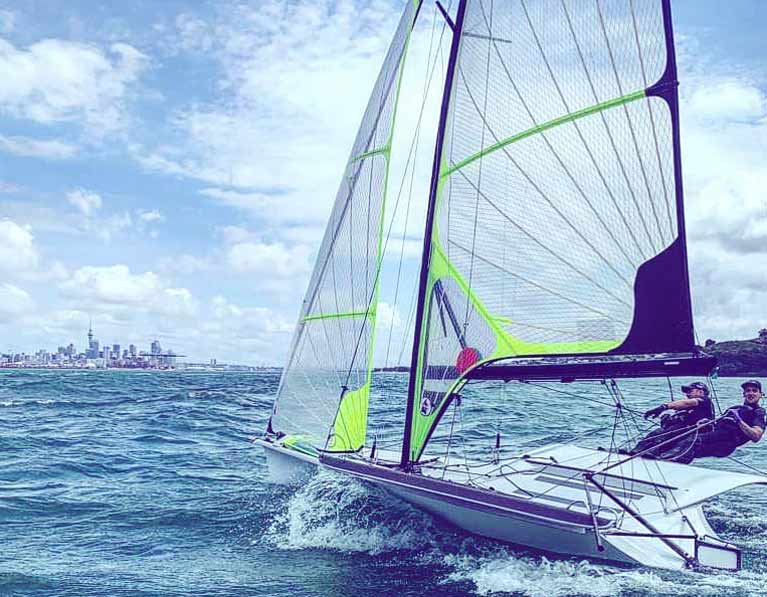 Ryan Seaton and Seafra Guilfoyle - silver fleet in Auckland
Ryan Seaton and Seafra Guilfoyle - silver fleet in Auckland
Last year in Genoa, the Belgium team of LeFebvre/Pelsmaekers were one place ahead of Italians Visconti/Togni, with Howth Yacht Club's Robert Dickson and Sean Waddilove 11 places further back. The top placing of a nation in contention was by the Russian team of Chekh/Zotov, but they could only manage 56th in this year’s worlds.
Perhaps the most consistent performers are the Swedes, Hedstrom/Hamel, but it is the two Irish teams that are currently enjoying upward results trajectories.
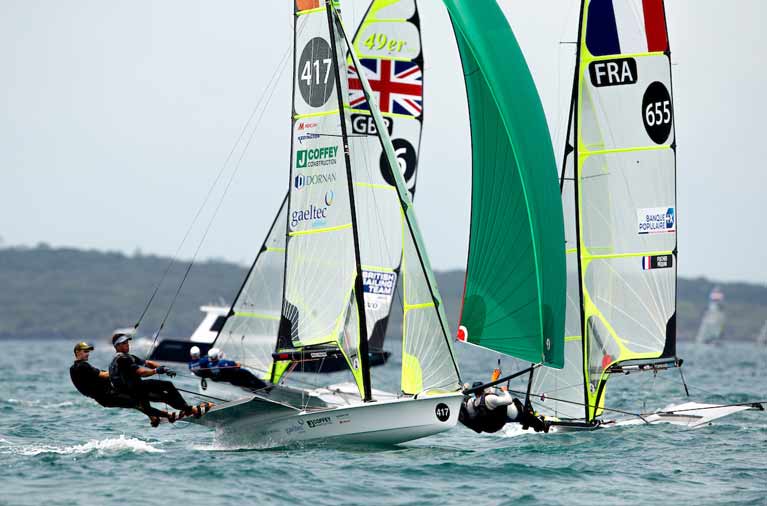 Robert Dickson and Sean Waddilove - gold fleet in Auckland
Robert Dickson and Sean Waddilove - gold fleet in Auckland
There is another World Championship in just two months time in Australia, but perhaps the Princesa Sofia regatta in Palma at the end of March will be the best indicator of form entering the decisive event. After all, that is a venue where Ryan Seaton has enjoyed one of his skiff career highs, winning the 2016 Trofeo Princesa event outright.
Read all Afloat's Olympic sailing coverage in one handy link here
Tokyo Olympic Berth Evades Irish 49er Crews in Auckland
Despite a bravo performance by young Dublin skiff sailors who finished in the top quarter of the 88-boat fleet, an Irish Tokyo 2020 berth was not secured in Auckland today.
Four European countries were selected this week in a championship won by multiple Olympic and now five-time world champions Peter Burling and Blair Tuke of New Zealand.
Now, in order to make the Tokyo startline at all, the two Irish skiff crews will be forced to scrap it out for one last remaining European country Olympic place to be decided in Genoa, Italy next April. It's a scenario that highlights why qualification at the 2018 Worlds in Aarhus was so important for Ireland two years ago.
Ireland, Belgium and Italy will be contenders for this single place (Ireland finished ahead of both Italy and Belgium this week) and the Irish Olympic representative will be decided by whichever crew qualifies the country, if any.
Team manager James O'Callaghan admits "Genoa will be a dogfight to qualify as it is a notoriously light airs and shifty venue".
22nd for Dickson & Waddilove
World Under 23 bronze medallists Robert Dickson (Howth YC) and Sean Waddilove (Skerries Sailing Club) ended the Gold fleet series in 22nd place overall in their best ever performance at senior level.
Highlights of the week for the Dublin pair were winning the opening race in the qualification round and a day of top ten results in the Gold fleet.
"This is a huge confidence boost, there's no reason we can't be back in the Gold fleet again."
Seaton Wants 'More Racing Experience'
Double-Olympic veteran Ryan Seaton (Ballyholme Yacht Club) with crew Séafra Guilfoyle (Royal Cork YC) didn't make the Gold fleet after losing out on a three-way tie-break on Thursday and sailed the remainder of the 17-race series in the Silver group.
"We're awfully disappointed with how our regatta turned out but very happy to see the young guys make Gold fleet," said Seaton. "But we know what we have to work to improve and it's not boat-speed - more racing experience will allow us to develop roles and better communication between us; we need to stick to our processes on board."
Spain, Austria, The Netherlands and Poland took the four country qualification places available in New Zealand.
Burling & Tuke Win Fifth World Title
Peter Burling and Blair Tuke have won a fifth world title to add to the four consecutive victories they enjoyed between 2013 and 2016. This will be one of the sweetest victories, however, not least because it’s on home waters, but also because of how hard the Kiwis were forced to work for this gold medal.
Erik Heil and Thomas Ploessel had made a bit of a mess of the previous day’s racing but the Germans really turned it on at the end of the competition. With Burling/ Tuke forced out of the first Gold Fleet race of the morning due to a broken tiller extension, the Germans had the opportunity to close the points gap. Heil/ Ploessel came from deep in the pack to record a ninth place and then were fast out of the blocks in the next race, winning that one at a canter. Fortunately for home fans Burling/ Tuke had recovered their composure to finish third behind the Germans.
This gave New Zealand an 8-point gap going into the double-points, 10-boat Medal Race, effectively a four-boat buffer on their German rivals. As good as in the bag for the talented New Zealanders, surely...
But no! While racing up the first beat the Germans forced the Kiwis to tack off and Burling slipped from his trapeze handle during the tack to almost capsize. Rounding the windward mark in ninth and out of gold medal position, Burling and Tuke turned on their downwind jets - moving up the fleet and with a few more passes were up into fourth. With the Germans in second there was nothing left that could be done by Heil and Ploessel. Burling and Tuke rose to the occasion despite showing some rare unforced errors, and were pushed hard all the way by Heil and Ploessel. After a bronze medal at the Rio 2016 Games, the Germans have displayed sufficient class to be able to dream of beating the New Zealanders to the top step at Tokyo 2020 next summer.
After looking like they might not even make the 25-boat cut for Gold Fleet earlier in the week, Diego Botin & Iago Marra (ESP) made the comeback of the regatta. The Spanish had a shot at the bronze medal if things went their way, and winning the Medal Race was the best way for them to conclude their time in Auckland. The 2017 World Champions Dylan Fletcher and Stuart Bithell (GBR) looked to be in trouble but the Brits finished 8th in the Medal Race which was sufficient to hang on to the last medal by a single point from the Spanish. At least the Spanish have done enough to secure a spot for the Olympic Games after failing to make the Gold Fleet at the previous Worlds in Denmark.
More World Championship Top Ten Results for Dickson & Waddilove in Hunt for Elusive Tokyo 2020 Place
Another three top ten results scored in the gold fleet of the 49er World Championships for Dubliners Robert Dickson (Howth YC) and Sean Waddilove (Skerries Sailing Club) moved the pairing up to 19th overall in Auckland Harbour today. It's been this week's stand out Irish performance that saw them overtake rivals double Olympian Ryan Seaton and Seafra Guilfoyle in the hunt for one of four elusive Tokyo places on offer in the 88-boat fleet.
The breeze on the race course today was a little softer than previous days, and at times extremely unpredictable and shifty.
The Irish Under 23 World Bronze medalists counted a seventh and a tenth are were heading for a race win in the third race when they were pipped into second place by multiple world and Olympic champions Peter Burling and Blair Tuke who now lead the regatta.
Unfortunately, despite the bravo performance in their first senior gold fleet event, Dickson and Waddilove only move up one country place to seventh, with the top four countries in the fleet qualifying this week for the Tokyo Olympics.
Pre-event forecasts indicated a top-eight finish would be required to secure a place. The gap for Dickson and Waddilove (currently in 19th overall) to that fourth country place occupied by Poland in tenth place is some 21 nett points. The battle continues on Sunday in two final gold fleet races in the morning followed by the double points medal races later in the day for the top ten in the fleet.
Racing in the Silver fleet, double-Olympic veteran Ryan Seaton (Ballyholme Yacht Club) with crew Séafra Guilfoyle (Royal Cork YC) overcame their disappointment from Thursday counting two top ten places and a 16th for the day and are 34th overall.
Failure to secure an Olympic berth this weekend means Ireland will look for the single final place on offer next year at the European Continental Championships in Genoa in April.
Burling and Tuke are the benchmark
Following four years of dominance leading up to their gold medal at Rio 2016, Burling and Tuke continue to prove that they are the benchmark in 49er racing. Heading into today’s racing the Olympic Champions needed to gain seven points to reel in the regatta leaders of Erik Heil / Thomas Ploessel (GER). Finishing the day with a race win, the four-time 49er World Champions amassed a 13 point lead over the second-placed Germans. However, they didn’t do it by themselves – with Heil / Ploessel stumbling in a major way to rack up a whopping 38 points from just three races.
Closing in on the top pair but with still a large gap are the 2017 World Champions Dylan Fletcher / Stuart Bithell (GBR). Even more interesting is the pack of four boats behind them with only 17 points separating this bunch, all of whom will be scrapping hard to climb on to the podium on Sunday.
Full results are here
Top Irish 49er Duo Dickson & Waddilove Lying 24th at World Championships
Plucky World Under 23 bronze medallists Robert Dickson (Howth YC) and Sean Waddilove (Skerries Sailing Club) are now 24th overall in the world championship and Olympic qualifier in New Zealand with two days of racing left to sail. As they chase one of four Olympic nation berths on offer this week in the fleet they are currently in eighth country position.
The pair counted two 20th places in Friday's racing in what is effectively their first taste of senior-level Gold fleet competition in the 88-boat fleet.
Full results are here
Ireland's chance of securing an Olympic berth narrowed when top hopes Double-Olympic veteran Ryan Seaton (Ballyholme Yacht Club) with crew Séafra Guilfoyle (Royal Cork YC), crashed out of the gold fleet on Wednesday. They continue the series in the Silver fleet where they count two top 20 results from day four of the competition and in 37th place overall.
Racing continues on Saturday and Sunday with the final series in Gold, Silver and Bronze fleets. Five races remain leading to a medal race final for the top ten boats. Eleven nations are already qualified for Tokyo with four further berths to be decided this week.
49er World Championship Gold Fleet Success for Dickson & Waddilove, Seaton & Guilfoyle in Silver
In only their third-ever appearance at a senior event, World Under 23 bronze medallists Robert Dickson (Howth YC) and Sean Waddilove (Skerries Sailing Club) have qualified for the 49er World Championships Gold fleet after a high stakes day in Auckland Harbour and stay in the hunt for a Tokyo 2020 Berth this week.
Double-Olympic Ryan Seaton (Ballyholme Yacht Club) with crew Séafra Guilfoyle (Royal Cork YC) missed a Gold fleet place in a three-way tie-break for 25th place and will sail the remainder of the series in the Silver fleet. Unfortunately, It is a return of the lack of consistency that has dogged the campaign billed as Ireland's top hope for Olympic qualification.
Results are here. Results denoted in a blue bar represent countries still seeking an Olympic place.
Following a nine-race qualification round at the 49er World Championship in Auckland, New Zealand today, the north Dublin pairing of Robert Dickson (Howth YC) and Sean Waddilove (Skerries Sailing Club) have qualified for the event Gold fleet, no doubt buoyed up by their opening race win on Monday.
Dickson and Waddilove remain in the hunt for one of four Tokyo 2020 Olympic nation places available this week but only four places are available with the sole Irish duo now lying in eighth unqualified country position and 20th place. A top-eight finish is predicted as the requirement to make the Tokyo cut.
The duo were extremely consistent scoring three top ten places of 3.0, 4.0 and 9.0 in qualifying races six, seven and eight to leapfrog the Irish favourites and sail into the gold fleet at the first time of asking.
"Regardless of where Rob and Sean finish, they've achieved a personal best and have had a great regatta," commented James O'Callaghan, Irish Sailing's Performance Director.
The end of the Qualifying Series in any Olympic-class World Championship is always a fraught scramble to make it through to the Gold Fleet Finals. Scrape through to the final 25 and you live to fight another three days. Fail to make the cut – and the best you can finish is 26th overall.
Add to that the fact that qualification to the Olympic Games is also on the line for many teams at the Hyundai 49er, 49erFX & Nacra 17 World Championships in Auckland, and there is an awful lot at stake for this group of committed sailors.
Seaton and Guilfoyle started the third day of racing with a sixth place in their flight, repeating their consistency from Wednesday. A dip in form followed with an 18th in the penultimate race. Starting with the leaders for race nine, an incident at the first turning-mark meant taking a penalty and they lost ten places to finish 18th once more.
"There's just no room for error and they had an error," said O'Callaghan. "Ryan and Séafra are very disappointed but they accept that it's a fine margin at this level and that they missed the cut for Gold fleet."
Racing continues on Friday with the final series in Gold, Silver and Bronze fleets leading to a medal race final for the top ten boats. Eleven nations are already qualified for Tokyo with four more countries to be decided this week. If qualification is not made this week, Ireland has one more chance to Q next year where a single final berth is on offer at the World Cup in Genoa.



























